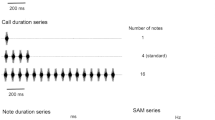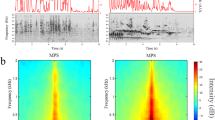Summary
-
1.
Neural activity (single neurons or evoked potentials) in response to repetitive acoustic stimulation was recorded at three different levels of the ascending auditory system in the bullfrog,Rana catesbeiana.
-
2.
Auditory fibers in the eighth nerve did not habituate in response to repeated stimuli.
-
3.
Evoked potentials from the principal nucleus of the torus semicircularis in the midbrain exhibited marked habituation only if the stimulus repetition rate was at least 1/s.
-
4.
Evoked potentials from the central nucleus of the dorsal thalamus, the primary diencephalic target of ascending fibers from the torus semicircularis, habituated in response to stimulation rates as slow as 1 every 10s. Thus there is a pronounced change in habituation to acoustic stimuli in the dorsal thalamus compared to the torus semicircularis. Furthermore, the habituation in the central nucleus was especially effective in response to sounds with amplitude spectra similar to that in the bullfrog's mating call (simultaneous low-frequency and high-frequency energy).
-
5.
Male bullfrogs living in a laboratory environment produced mating calls in response to playbacks of taped bullfrog mating calls. This evoked calling habituated in response to repeated playbacks.
-
6.
Maximal evoked calling occurred at stimulus repetition rates that did not produce neural habituation in the central nucleus. These results suggest that auditory processing in the central nucleus of the dorsal thalamus may be important in mediating the evoked calling behavior of the bullfrog.
Similar content being viewed by others
Abbreviations
- BEF :
-
best excitatory frequency
References
Blair WF (1958) Mating call in the speciation of anuran amphibians. Am Nat 92:27–51
Bogert CM (1960) The influence of sound on the behavior of amphibians and reptiles. In: Lanyon WE, Tavolga WE (eds) Animal sounds and communication. American Institute of Biological Sciences, Washington DC
Buchwald JS, Humphrey GL (1973) An analysis of habituation in the specific sensory systems. In: Stellar E, Sprague JM (eds) Progress in physiological psychology, vol 5. Academic Press, New York
Capranica RR (1965) Evoked vocal response of the bullfrog. MIT Press, Cambridge
Capranica RR (1976) Morphology and physiology of the auditory system. In: Llinás RL, Precht W (eds) Frog neurobiology. Springer, Berlin Heidelberg New York, pp 551–575
Capranica RR (1978) Auditory processing in anurans. Fed Proc 37:2324–2328
Capranica RR, Moffat AJM (1982) Neuroethological principles of acoustic communication in anurans. In: Ewert J-P, Capranica RR, Ingle DJ (eds) Advances in vertebrate neuroethology. Plenum Press, London (in press)
Emlen ST (1976) Lek organization and mating strategies in the bullfrog. Behav Ecol Sociobiol 1:283–313
Feng AS, Narins PM, Capranica RR (1975) Three populations of primary auditory fibers in the bullfrog (Rana catesbeiand): Their peripheral origins and frequency sensitivities. J Comp Physiol 100:221–229
Fuller PM, Ebbesson SOE (1973) Projections of the primary and secondary auditory fibers in the bullfrog (Rana catesbeiana). Neurosci Abstr 3:333
Fuzessery ZM, Feng AS (1982) Frequency selectivity in the anuran auditory midbrain: single unit responses to single and multiple tone stimulation. J Comp Physiol 146:471–484
Gerhardt HC (1974) Behavioral isolation of the tree frogs,Hyla cinerea andHyla andersonii. Am Midi Nat 91:424–433
Gregory KM (1972) Central projections of the eighth nerve in frogs. Brain Behav Ecol 5:70–88
Grofova I, Corvaja N (1972) Commissural projection from the nuclei of termination of the VIIIth cranial nerve in the toad. Brain Res 42:189–195
Hall RD (1968) Habituation of evoked potentials in the rat under conditions of behavioral control. Electroencephalogr Clin Neurophysiol 24:155–165
Huang C-M, Buchwald JS (1979a) Response of cochlear nucleus neurons in the unanesthetized cat to slowly repeated tones. Exp Neurol 66:64–77
Huang C-M, Buchwald JS (1979b) A comparison of acoustic nerve and cochlear nucleus responses during acoustic habituation. Brain Res 173:562–566
Jaffe SL, Bourlier PF, Hagamen WD (1969) Adaptation of evoked auditory potentials: A midbrain through frontal lobe map in the unanesthetized cat. Brain Res 15:121–136
Kicliter E (1979) Some telencephalic connections in the frog,Rana pipiens. J Comp Neurol 185:75–86
Krebs JR (1976) Habituation and song repertoires in the great tit. Behav Ecol Sociobiol 1:215–227
Lewis ER, Leverenz EL, Koyama M (1982) The tonotopic organization of the bullfrog amphibian papilla, an auditory organ lacking a basilar membrane. J Comp Physiol 145:437–445
Megela AL (1982) Auditory response properties of the anuran thalamus: nonlinear facilitation. In: Ewert J-P, Capranica RR, Ingle DJ (eds) Advances in vertebrate neuroethology. Plenum Press, London (in press)
Megela AL, Capranica RR (1981) Response patterns to tone bursts in peripheral auditory system of anurans. J Neurophysiol 46:465–479
Mudry KM (1978) A comparative study of the response properties of higher auditory nuclei in anurans: Correlation with species-specific vocalizations. PhD thesis, Cornell University
Mudry KM, Constantine-Paton M, Capranica RR (1977) Auditory sensitivity of the diencephalon of the leopard frog,Rana p. pipiens. J Comp Physiol 114:1–13
Neary TJ (1974) Diencephalic efferents of the torus semicircularis in the bullfrog,Rana catesbeiana. Anat Rec 178:425
Neary TJ (1975) Architectonics of the thalamus of the bullfrog (Rana catesbeiana): a histochemical analysis. Anat Rec 181:434–435
Neary TJ, Wilczynski W (1979) Anterior and posterior thalamic afferents in the bullfrog,Rana catesbeiana. Neurosci Abstr 5:144
Petrinovich L, Patterson TL (1979) Field studies of habituation: I. Effect of reproductive condition, number of trials, and different delay intervals on responses of the whitecrowned sparrow. J Comp Physiol Psychol 93:337–350
Petrinovich L, Peeke HVS (1973) Habituation to territorial song in the white-crowned sparrow (Zonotrichia leucophrys). Behav Biol 8:743–748
Potter HD (1965) Patterns of acoustically evoked discharges of neurons in the mesencephalon of the bullfrog. J Neurophysiol 28:1155–1184
Rose G, Capranica RR (1983) Temporal selectivity in the central auditory system of the leopard frog. Science 219:1087–1089
Rubinson K, Skiles MP (1975) Efferent projections of the superior olivary nucleus in the frogRana catesbeiana. Brain Behav Evol 12:151–160
Thompson RF, Spencer WA (1966) Habituation: A model phenomenon for the study of neuronal substrates of behavior. Psychol Rev 173:16–43
Walkowiak W (1980) The coding of auditory signals in the torus semicircularis of the fire-bellied toad and the grass frog: responses to simple stimuli and to conspecific calls. J Comp Physiol 138:131–148
Webster WR (1971) The effects of repetitive stimulation on auditory evoked potentials. Electroencephalogr Clin Neurophysiol 30:318–330
Webster WR, Bock GR (1971) The effects of repetitive stimulation on the rat inferior colliculus. Electroencephalogr Clin Neurophysiol 30:331–336
Wells KD (1977) The social behavior of anuran amphibians. Anim Behav 25:666–693
Wester K (1971) Habituation to electrical stimulation of the thalamus in unanesthetized cats. Electroencephalogr Clin Neurophysiol 30:52–61
Wickelgren WO (1968) Effect of acoustic habituation on clickevoked responses in cats. J Neurophysiol 31:777–784
Wilczynski W (1981) Afferents to the midbrain auditory center in the bullfrog,Rana catesbeiana. J Comp Neurol 198:421–433
Yasukawa K (1981) Song repertoires in the red-winged blackbird (Agelaius phoeniceus): A test of the Beau Gest hypothesis. Anim Behav 29:114–125
Author information
Authors and Affiliations
Rights and permissions
About this article
Cite this article
Megela, A.L., Capranica, R.R. A neural and behavioral study of auditory habituation in the bullfrog,Rana catesbeiana . J. Comp. Physiol. 151, 423–434 (1983). https://doi.org/10.1007/BF00605458
Accepted:
Issue Date:
DOI: https://doi.org/10.1007/BF00605458




